Lake District: Difference between revisions
Created page with 'right|thumb|800px|Keswick and Derwent Water, from Walla Crag {{clear}} The '''Lake District''' is a mountainous region spreading over the…' |
|||
| (7 intermediate revisions by 3 users not shown) | |||
| Line 10: | Line 10: | ||
==Towns and villages== | ==Towns and villages== | ||
The extent of the Lake District has no precise definition but covers perhaps about 900 square miles of hill and dale in the three counties of Cumberland, | The extent of the Lake District has no precise definition but covers perhaps about 900 square miles of hill and dale in the three counties of Cumberland, Lancaster and Westmorland. Its northern and western edges are maked off by the [[River Eden, Cumberland|Eden Valley]] and the broad plains beside the [[Solway Firth]]. To the west of the fells is Cumberland's coastal plain, and to the south [[Barrow in Furness]] sits on low gorund but otherwise the fell country reaches to the [[Irish Sea]]. | ||
The Lake District is one of the most highly populated national parks, but within the whole of the Lake District there is only a handful of sizable towns. The towns of: | The Lake District is one of the most highly populated national parks, but within the whole of the Lake District there is only a handful of sizable towns. The towns of: | ||
| Line 40: | Line 40: | ||
==Fells== | ==Fells== | ||
[[File:Scafells.jpg|right|thumb|The Scafell massif, seen over Wasdale]] | [[File:Scafells.jpg|right|thumb|220px|The Scafell massif, seen over Wasdale]] | ||
The six highest mountains in the Lake District exceed 3000 feet and are thus classified as "[[Furth Munro]]s". These are; | The six highest mountains in the Lake District exceed 3000 feet and are thus classified as "[[Furth Munro]]s". These are; | ||
| Line 62: | Line 62: | ||
[[Bassenthwaite Lake]] occupies the valley between this massif and the North Western Fells. | [[Bassenthwaite Lake]] occupies the valley between this massif and the North Western Fells. | ||
===North Western Fells=== | |||
[[File:Glenridding, Cumbria, England - June 2009.jpg|right|thumb|Glenridding and Ullswater]] | [[File:Glenridding, Cumbria, England - June 2009.jpg|right|thumb|220px|Glenridding and Ullswater]] | ||
The North Western Fells stand between [[Borrowdale]] and [[Bassenthwaite Lake]] to the east and [[Buttermere]] and [[Lorton Vale]] to the west, all in [[Cumberland]]. Their southernmost point is at [[Honister Pass]]. | The North Western Fells stand between [[Borrowdale]] and [[Bassenthwaite Lake]] to the east and [[Buttermere]] and [[Lorton Vale]] to the west, all in [[Cumberland]]. Their southernmost point is at [[Honister Pass]]. | ||
| Line 71: | Line 71: | ||
===Western Fells=== | ===Western Fells=== | ||
[[File:Wast Water from Great Gable.jpg|right|thumb| | [[File:Wast Water from Great Gable.jpg|right|thumb|220px|Wast Water]] | ||
The Western Fells lie all in [[Cumberland]] between [[Buttermere]] and [[Wasdale]], with [[Sty Head]] forming the apex of a large triangle. [[Ennerdale Water|Ennerdale]] bisects the area, which consists of the [[High Stile]] ridge north of Ennerdale, the [[Loweswater Fells]] in the far north west, the [[Pillar]] group in the south west, and [[Great Gable]], 2,949 feet near Sty Head. | The Western Fells lie all in [[Cumberland]] between [[Buttermere]] and [[Wasdale]], with [[Sty Head]] forming the apex of a large triangle. [[Ennerdale Water|Ennerdale]] bisects the area, which consists of the [[High Stile]] ridge north of Ennerdale, the [[Loweswater Fells]] in the far north west, the [[Pillar]] group in the south west, and [[Great Gable]], 2,949 feet near Sty Head. | ||
| Line 77: | Line 77: | ||
===Central Fells=== | ===Central Fells=== | ||
The Central Fells, in [[Cumberland]] and [[Westmorland]], are lower in elevation than surrounding areas of fell, peaking at 2,500 feet at [[High Raise, Langdale|High Raise]]. They take the form of a ridge running between [[Derwent Water]] in the west and [[Thirlmere]] in the east, from [[Keswick]] in the north to [[Langdale Pikes]] in the south. A spur extends southeast to [[Loughrigg Fell]] above [[Ambleside]]. The central ridge running north over [[High Seat]] is exceptionally boggy. | The Central Fells, in [[Cumberland]] and [[Westmorland]], are lower in elevation than surrounding areas of fell, peaking at 2,500 feet at [[High Raise, Langdale|High Raise]]. They take the form of a ridge running between [[Derwent Water]] in the west and [[Thirlmere]] in the east, from [[Keswick]] in the north to [[Langdale Pikes]] in the south. A spur extends southeast to [[Loughrigg Fell]] above [[Ambleside]]. The central ridge running north over [[High Seat, Cumberland|High Seat]] is exceptionally boggy. | ||
===Eastern Fells=== | ===Eastern Fells=== | ||
| Line 85: | Line 85: | ||
===Far Eastern Fells=== | ===Far Eastern Fells=== | ||
[[File:Haweswater from Harter Fell 3.jpg|right|thumb|Haweswater Reservoir from Harter Fell]] | [[File:Haweswater from Harter Fell 3.jpg|right|thumb|220px|Haweswater Reservoir from Harter Fell]] | ||
The | The Far Eastern Fells refer to all of the Lakeland fells of Westmorland to the east of Ullswater and the A592 road running south to Windermere. At 2,717 feet, the peak known as [[High Street]] is the highest point on a complex ridge which runs broadly north-south and overlooks the hidden valley of Haweswater to its east. | ||
In the north of this region are the lower fells of Martindale Common and Bampton Common whilst in the south are the fells overlooking the [[Kentmere]] valley. Further to the east, beyond [[Mardale]] and [[Longsleddale]] is [[ | In the north of this region are the lower fells of Martindale Common and Bampton Common whilst in the south are the fells overlooking the [[Kentmere]] valley. Further to the east, beyond [[Mardale]] and [[Longsleddale]] is [[Shap Fell]], an extensive area consisting of high moorland, more rolling and [[Pennines|Pennine]] in nature than the mountains to the west. | ||
===Southern Fells=== | ===Southern Fells=== | ||
[[File:Coniston Water from Holme Fell.jpg|right|thumb| | [[File:Coniston Water from Holme Fell.jpg|right|thumb|220px|Coniston Water from Holme Fell]] | ||
The | The Southern Fells occupy the south of Cumberland and the [[Furness Fells]] of Lancashire, all in southwestern quarter of the Lake District. They can be regarded as comprising a northern grouping between Wasdale, Eskdale and the two Langdale valleys, a southeastern group east of Dunnerdale and south of Little Langdale and a southwestern group bounded by Eskdale to the north and Dunnerdale on the Lancashire boundary to the east. | ||
The first group, in Cumberland, includes England's highest mountains; [[Scafell Pike]] in the centre, at 3,209 feet and [[Scafell]] a mile to the south-west. Though it is slightly lower it has a 700-foot rockface, Scafell Crag on its northern side. It also includes the [[Wastwater Screes]] overlooking Wasdale, the [[Glaramara]] ridge overlooking Borrowdale, the three tops of [[Crinkle Crags]], [[Bowfell]] and [[Esk Pike]]. The core of the area is drained by the infant River Esk. Collectively these are some of the Lake District's most rugged hillsides. | The first group, in Cumberland, includes England's highest mountains; [[Scafell Pike]] in the centre, at 3,209 feet and [[Scafell]] a mile to the south-west. Though it is slightly lower it has a 700-foot rockface, Scafell Crag on its northern side. It also includes the [[Wastwater Screes]] overlooking Wasdale, the [[Glaramara]] ridge overlooking Borrowdale, the three tops of [[Crinkle Crags]], [[Bowfell]] and [[Esk Pike]]. The core of the area is drained by the infant River Esk. Collectively these are some of the Lake District's most rugged hillsides. | ||
| Line 197: | Line 197: | ||
==Economy== | ==Economy== | ||
===Agriculture and forestry=== | ===Agriculture and forestry=== | ||
[[File:Forestry on Harter Fell.jpg|right|thumb|Forestry operations on Harter Fell]] | [[File:Forestry on Harter Fell.jpg|right|thumb|220px|Forestry operations on Harter Fell]] | ||
Farming, and in particular sheep farming, has been the major industry in the region since the dawn of time. The breed most closely associated with the area is the tough Herdwick, with Rough Fell and Swaledale sheep also common. Sheep farming remains important both for the economy of the region and for preserving the landscape which visitors want to see. Features such as dry stone walls, for example, are there as a result of sheep farming. Some land is also used for silage and dairy farming. | Farming, and in particular sheep farming, has been the major industry in the region since the dawn of time. The breed most closely associated with the area is the tough Herdwick, with Rough Fell and Swaledale sheep also common. Sheep farming remains important both for the economy of the region and for preserving the landscape which visitors want to see. Features such as dry stone walls, for example, are there as a result of sheep farming. Some land is also used for silage and dairy farming. | ||
The area was badly affected by the outbreak of foot-and-mouth disease across the United Kingdom in 2001, or more particularly it was badly afffeced by the panicked reaction of the Department of Agriculture in ordering the destruction of even uninfected herds anywhere close to an outbreak. The foot and mouth outbreak was first detected in [[Surrey]] in February, but was being detected in the fells by end of March.<ref>{{Cite news |title=Lake District 'nightmare' as fell farm is infected |last=Cadwalladr |first=Carole |url=http://www.telegraph.co.uk/news/uknews/1327961/Lake-District-nightmare-as-fell-farm-is-infected.html |newspaper=The Telegraph |date=26 March 2001 |accessdate=2012-08-27}}</ref> Thousands of sheep, include the native Herdwick which graze on the fellsides across the District, were destroyed. In replacing the sheep, one problem to overcome was that many of the lost sheep were heafed, that is, they knew their part of the unfenced fell and did not stray, with this knowledge being passed between generations. With all the sheep lost at once, this knowledge has to be re-learnt and some of the fells have had discreet electric fences strung across them for a period of five years, to allow the sheep to "re-heaf".<ref>{{Cite news |title='If they go, it is the end of Lakeland' |last=Griffin |first=Harry |url=http://www.guardian.co.uk/uk/2001/apr/11/footandmouth.features11 |newspaper=The Guardian |date=11 April 2001 |accessdate=2012-08-27}}</ref> At the time of the outbreak, worries existed about the future of certain species of sheep such as Ryeland and Herdwick in the District,<ref>{{Cite news |title=Rare breeds 'could be lost' |last=MacClean |first=Matt |url=http://news.bbc.co.uk/1/hi/uk/1233458.stm |work=BBC News |date=21 March 2001 |accessdate=2012-08-27}}</ref> however these fears have been allayed and sheep now occupy the District in abundance.<ref>{{Cite news |title=Sheep breed resurrected decade on from foot and mouth |last=Clarke |first=Tom |url=http://www.channel4.com/news/sheep-breed-resurrected-decade-on-from-foot-and-mouth |work=Channel 4 News |date=9 February 2011 |accessdate=2012-08-27}}</ref> | The area was badly affected by the outbreak of foot-and-mouth disease across the United Kingdom in 2001, or more particularly it was badly afffeced by the panicked reaction of the Department of Agriculture in ordering the destruction of even uninfected herds anywhere close to an outbreak. The foot and mouth outbreak was first detected in [[Surrey]] in February, but was being detected in the fells by end of March.<ref>{{Cite news |title=Lake District 'nightmare' as fell farm is infected |last=Cadwalladr |first=Carole |url=http://www.telegraph.co.uk/news/uknews/1327961/Lake-District-nightmare-as-fell-farm-is-infected.html |newspaper=The Telegraph |date=26 March 2001 |accessdate=2012-08-27}}</ref> Thousands of sheep, include the native Herdwick which graze on the fellsides across the District, were destroyed. In replacing the sheep, one problem to overcome was that many of the lost sheep were heafed, that is, they knew their part of the unfenced fell and did not stray, with this knowledge being passed between generations. With all the sheep lost at once, this knowledge has to be re-learnt and some of the fells have had discreet electric fences strung across them for a period of five years, to allow the sheep to "re-heaf".<ref>{{Cite news |title='If they go, it is the end of Lakeland' |last=Griffin |first=Harry |url=http://www.guardian.co.uk/uk/2001/apr/11/footandmouth.features11 |newspaper=The Guardian |date=11 April 2001 |accessdate=2012-08-27}}</ref> At the time of the outbreak, worries existed about the future of certain species of sheep such as Ryeland and Herdwick in the District,<ref>{{Cite news |title=Rare breeds 'could be lost' |last=MacClean |first=Matt |url=http://news.bbc.co.uk/1/hi/uk/1233458.stm |work=BBC News |date=21 March 2001 |accessdate=2012-08-27}}</ref> however these fears have been allayed and sheep now occupy the District in abundance.<ref>{{Cite news |title=Sheep breed resurrected decade on from foot and mouth |last=Clarke |first=Tom |url=http://www.channel4.com/news/sheep-breed-resurrected-decade-on-from-foot-and-mouth |work=Channel 4 News |date=9 February 2011 |accessdate=2012-08-27}}</ref> | ||
[[File:Thirleme 069.jpg|thumb|A Herdwick grazing above Thirlmere]] | [[File:Thirleme 069.jpg|right|thumb|220px|A Herdwick grazing above Thirlmere]] | ||
Forestry has also assumed greater importance over the course of the last century with the establishment of extensive conifer plantations around [[Whinlatter Pass]], in [[Ennerdale Water|Ennerdale]] and at [[Grizedale Forest]] amongst other places. There are extensive plantations of non-native pine trees. | Forestry has also assumed greater importance over the course of the last century with the establishment of extensive conifer plantations around [[Whinlatter Pass]], in [[Ennerdale Water|Ennerdale]] and at [[Grizedale Forest]] amongst other places. There are extensive plantations of non-native pine trees. | ||
| Line 210: | Line 210: | ||
Mining, particularly of copper, lead (often associated with quantities of silver), baryte, graphite and slate, was historically a major Lakeland industry, mainly from the 16th century to the 19th century. Coppiced woodland was used extensively to provide charcoal for smelting. Some mining still takes place today; for example, slate mining continues at the Honister Mines, at the top of [[Honister Pass]]. Abandoned mine-workings can be found on fell-sides throughout the district. The locally mined graphite led to the development of the pencil industry, especially around [[Keswick]]. | Mining, particularly of copper, lead (often associated with quantities of silver), baryte, graphite and slate, was historically a major Lakeland industry, mainly from the 16th century to the 19th century. Coppiced woodland was used extensively to provide charcoal for smelting. Some mining still takes place today; for example, slate mining continues at the Honister Mines, at the top of [[Honister Pass]]. Abandoned mine-workings can be found on fell-sides throughout the district. The locally mined graphite led to the development of the pencil industry, especially around [[Keswick]]. | ||
[[File:Lake District near Torver.jpg|right|thumb|A typical Lake District scene]] | [[File:Lake District near Torver.jpg|right|thumb|300px|A typical Lake District scene]] | ||
In the middle of the 19th century, half the world textile industry's bobbin supply came from the Lake District area. Over the past century, however, tourism has grown rapidly to become the area's primary source of income. | In the middle of the 19th century, half the world textile industry's bobbin supply came from the Lake District area. Over the past century, however, tourism has grown rapidly to become the area's primary source of income. | ||
| Line 233: | Line 233: | ||
The railways led to another expansion in tourism. The Kendal and Windermere Railway was the first to penetrate the Lake District, reaching [[Kendal]] in 1846 and [[Windermere]] in 1847. The line to [[Coniston]] opened in 1848 (although until 1857 this was only linked to the national network with ferries between [[Fleetwood]] and [[Barrow-in-Furness]]); the line from [[Penrith]] through [[Keswick]] to [[Cockermouth]] in 1865; and the line to [[Lakeside, Lancashire|Lakeside]] at the foot of [[Windermere]] in 1869. The railways, built with traditional industry in mind, brought with them a huge increase in the number of visitors, thus contributing to the growth of the tourism industry. Railway services were supplemented by steamer boats on the major lakes of [[Ullswater]], Windermere, [[Coniston Water]], and [[Derwent Water]]. | The railways led to another expansion in tourism. The Kendal and Windermere Railway was the first to penetrate the Lake District, reaching [[Kendal]] in 1846 and [[Windermere]] in 1847. The line to [[Coniston]] opened in 1848 (although until 1857 this was only linked to the national network with ferries between [[Fleetwood]] and [[Barrow-in-Furness]]); the line from [[Penrith]] through [[Keswick]] to [[Cockermouth]] in 1865; and the line to [[Lakeside, Lancashire|Lakeside]] at the foot of [[Windermere]] in 1869. The railways, built with traditional industry in mind, brought with them a huge increase in the number of visitors, thus contributing to the growth of the tourism industry. Railway services were supplemented by steamer boats on the major lakes of [[Ullswater]], Windermere, [[Coniston Water]], and [[Derwent Water]]. | ||
[[File:STEAMER ON ULLSWATER.jpg|right|thumb| | [[File:STEAMER ON ULLSWATER.jpg|right|thumb|220px|A steamer on Ullswater]] | ||
The growth in tourist numbers continued into the age of the motor car, when railways began to be closed or run down. The formation of the Lake District National Park in 1951 recognised the need to protect the Lake District environment from excessive commercial or industrial exploitation, preserving that which visitors come to see, without any restriction on the movement of people into and around the district. The [[M6 Motorway]] helped bring traffic to the Lakes, passing up its eastern flank. The narrow roads present a challenge for traffic flow and, from the 1960s, certain areas have been very congested. | The growth in tourist numbers continued into the age of the motor car, when railways began to be closed or run down. The formation of the Lake District National Park in 1951 recognised the need to protect the Lake District environment from excessive commercial or industrial exploitation, preserving that which visitors come to see, without any restriction on the movement of people into and around the district. The [[M6 Motorway]] helped bring traffic to the Lakes, passing up its eastern flank. The narrow roads present a challenge for traffic flow and, from the 1960s, certain areas have been very congested. | ||
| Line 297: | Line 297: | ||
{{Catself}} [[Category:Cumberland]] [[Category:Lancashire]] [[Category:Westmorland]] | {{Catself}} [[Category:Cumberland]] [[Category:Lancashire]] [[Category:Westmorland]] | ||
[[Category:National Parks | [[Category:National Parks of the United Kingdom]] | ||
Latest revision as of 17:48, 19 June 2017
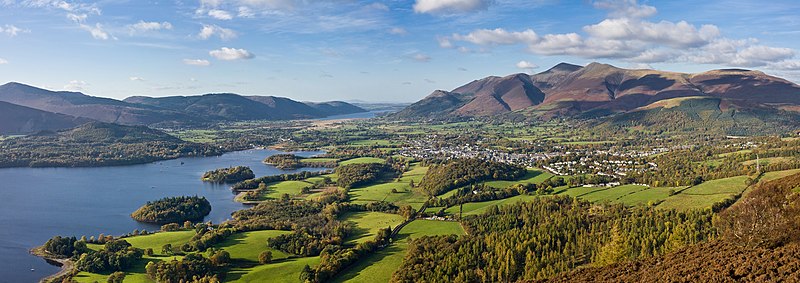
The Lake District is a mountainous region spreading over the greater part of Cumberland, Westmorland and Lancashire North of the Sands, and in this narrow compass are found some of the greatest natural spectacles of the land.
All the land in England higher than three thousand feet above sea level lies within the Lake District, which height is represented by six Furth Munros in Cumberland, including Scafell Pike, the highest mountain in England at 3,209 feet. It also contains the deepest and longest lakes in England, Wastwater (Cumberland) and Windermere (Lancashire / Westmorland), respectively.
The Lakes are a popular holiday destination. The region is famous for its lakes, forests and fells and for the way in which these were romantically portrayed in the 19th century in the poetry and writings of William Wordsworth, a Westmorland man, and the other "Lake Poets".
The Lake District was designated a National Park on 9 May 1951, the second National Park in the United Kingdom, following the Peak District and today the second-largest. It is the most visited too, with 15.8 million visitors a year and over 23 day visits each year.
Towns and villages
The extent of the Lake District has no precise definition but covers perhaps about 900 square miles of hill and dale in the three counties of Cumberland, Lancaster and Westmorland. Its northern and western edges are maked off by the Eden Valley and the broad plains beside the Solway Firth. To the west of the fells is Cumberland's coastal plain, and to the south Barrow in Furness sits on low gorund but otherwise the fell country reaches to the Irish Sea.
The Lake District is one of the most highly populated national parks, but within the whole of the Lake District there is only a handful of sizable towns. The towns of:
- Cumberland
- Westmorland:
At the edge of the fell country are Barrow-in-Furness, Ulverston and Grange-over-Sands (Lancashire) and Cockermouth (Cumberland) and each is economically important.
Villages such as Coniston, Threlkeld, Pooley Bridge, Broughton-in-Furness, Grasmere, Newby Bridge, Staveley-in-Westmorland, Lindale, Gosforth and Hawkshead act as more local centres. The economies of almost all are intimately linked with tourism.
Beyond these are a scatter of hamlets and innumerable isolated farmsteads, some of which are still tied to agriculture, others now function as part of the tourist economy.
Landscape
As the highest ground in England, Scafell Pike naturally has a very extensive view, ranging from the Mourne Mountains in County Down to Snowdonia in Caernarfonshire. The Lake District takes the form of a roughly circular upland massif deeply dissected by a broadly radial pattern of major valleys whose character is largely the product of repeated glaciations over the last 2 million years. Most of these valleys display the U-shape cross-section, characteristic of glacial origin and often contain elongate lakes occupying sizeable bedrock hollows often with tracts of relatively flat ground at their heads. Smaller lakes known as tarns occupy corries (glacial cirques) at higher elevations. It is the abundance of both which has led to the area's becoming known as the Lake District.
The mountains of the Lake District are also known as the "Cumbrian Mountains", a name found less frequently today than in former ages. The more frequent names are "the Lake District" or "the Lakeland Fells".
Many of the higher fells are rocky in character, whilst moorland predominates at lower altitude. Vegetation cover across better drained areas includes bracken and heather though much of the land is boggy, due to the high rainfall. Deciduous native woodland occurs on many steeper slopes below the tree line but with native oak supplemented by extensive conifer plantations in many areas, particularly Grisedale Forest in Furness in the south part of the area.
Dales
The principal radial valleys are (clockwise from the south) those of Dunnerdale, Eskdale, Wasdale, Ennerdale, Lorton Vale and the Buttermere valley, the Derwent valley and Borrowdale, the valleys containing Ullswater and Haweswater, Longsleddale, the Kentmere valley and those radiating from the head of Windermere including Great Langdale. The valleys serve to break the mountains up into separate blocks which have been described by various authors in different ways. The most frequently encountered approach is that made popular by Alfred Wainwright who published seven separate area guides to the Lakeland Fells;
Fells

The six highest mountains in the Lake District exceed 3000 feet and are thus classified as "Furth Munros". These are;
| Scafell Pike | 3,210 feet |
| Scafell | 3,162 feet |
| Helvellyn | 3,118 feet |
| Ill Crag | 3,068 feet |
| Skiddaw | 3,054 feet |
| Broad Crag | 3,064 feet |
Northern Fells
The Northern Fells are a readily defined range of hills contained within a 8-mile diameter circle between Keswick in the southwest and Caldbeck in the northeast. They culminate in the Skiddaw, rising to 3,054 feet. Other notable peaks are those of Blencathra (also known as Saddleback) at 2,848 feet and Carrock Fell.
Bassenthwaite Lake occupies the valley between this massif and the North Western Fells.
North Western Fells
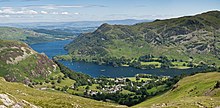
The North Western Fells stand between Borrowdale and Bassenthwaite Lake to the east and Buttermere and Lorton Vale to the west, all in Cumberland. Their southernmost point is at Honister Pass.
This area includes the Derwent Fells above the Newlands Valley and hills to the north amongst which are Dale Head, Robinson. To the north stand Grasmoor, the highest in the range at 2,795 feet, Grisedale Pike and the hills around the valley of Coledale, and in the far northwest is Thornthwaite Forest and Lord's Seat.
The fells in this area are rounded Skiddaw Slate, with few tarns and relatively few rock faces.
Western Fells

The Western Fells lie all in Cumberland between Buttermere and Wasdale, with Sty Head forming the apex of a large triangle. Ennerdale bisects the area, which consists of the High Stile ridge north of Ennerdale, the Loweswater Fells in the far north west, the Pillar group in the south west, and Great Gable, 2,949 feet near Sty Head.
Other tops include Seatallan, Haystacks and Kirk Fell. This area is craggy and steep, with the impressive pinnacle of Pillar Rock its showpiece. Wastwater, in this part, is the deepest lake in England.
Central Fells
The Central Fells, in Cumberland and Westmorland, are lower in elevation than surrounding areas of fell, peaking at 2,500 feet at High Raise. They take the form of a ridge running between Derwent Water in the west and Thirlmere in the east, from Keswick in the north to Langdale Pikes in the south. A spur extends southeast to Loughrigg Fell above Ambleside. The central ridge running north over High Seat is exceptionally boggy.
Eastern Fells
The Eastern Fells, in Cumberland and Westmorland, consist of a long north-to-south ridge marking the county boundary, the Helvellyn range, running from Clough Head to Seat Sandal with the 3,118 feet of Helvellyn at its highest point. The western slopes of these summits tend to be grassy, with rocky corries and crags on the eastern side.
The Fairfield group lies to the south of the range, and forms a similar pattern with towering rock faces and hidden valleys spilling into the Patterdale valley. It culminates in the height of Red Screes overlooking the Kirkstone Pass.
Far Eastern Fells
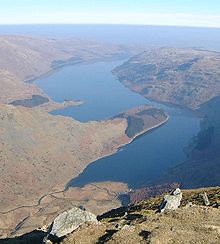
The Far Eastern Fells refer to all of the Lakeland fells of Westmorland to the east of Ullswater and the A592 road running south to Windermere. At 2,717 feet, the peak known as High Street is the highest point on a complex ridge which runs broadly north-south and overlooks the hidden valley of Haweswater to its east.
In the north of this region are the lower fells of Martindale Common and Bampton Common whilst in the south are the fells overlooking the Kentmere valley. Further to the east, beyond Mardale and Longsleddale is Shap Fell, an extensive area consisting of high moorland, more rolling and Pennine in nature than the mountains to the west.
Southern Fells
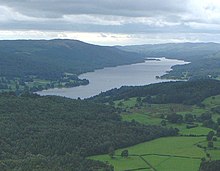
The Southern Fells occupy the south of Cumberland and the Furness Fells of Lancashire, all in southwestern quarter of the Lake District. They can be regarded as comprising a northern grouping between Wasdale, Eskdale and the two Langdale valleys, a southeastern group east of Dunnerdale and south of Little Langdale and a southwestern group bounded by Eskdale to the north and Dunnerdale on the Lancashire boundary to the east.
The first group, in Cumberland, includes England's highest mountains; Scafell Pike in the centre, at 3,209 feet and Scafell a mile to the south-west. Though it is slightly lower it has a 700-foot rockface, Scafell Crag on its northern side. It also includes the Wastwater Screes overlooking Wasdale, the Glaramara ridge overlooking Borrowdale, the three tops of Crinkle Crags, Bowfell and Esk Pike. The core of the area is drained by the infant River Esk. Collectively these are some of the Lake District's most rugged hillsides.
A second group in Cumberland to the west of the River Duddon includes Harter Fell and the long ridge leading over Whitfell to Black Combe and the sea. The south of this region consists of lower forests and knolls, with Kirkby Moor on the southern boundary. The south-western Lake District ends near the Furness peninsula and Barrow-in-Furness, an industrial town on which many Lake District residents rely for basic amenities.
The Furness Fells or Coniston Fells are in Lancashire North of the Sands and have as their northern boundary the county border on the steep and narrow Hardknott and Wrynose Passes.
South Eastern area
The south-eastern area is the territory between Coniston Water and Windermere and east of Windermere towards Kendal and south to Lindale. There are no high summits in this area which is mainly low hills, knolls and limestone cuestas such as Gummer's How and Whitbarrow. Indeed it rises only as high as 1,000 feet at Top o' Selside east of Coniston Water; The wide expanse of Grizedale Forest stands between the two lakes. Kendal and Morecambe Bay stand at the eastern and southern edges of the area.
Lakes
Only one of the lakes in the Lake District is called by the name of "Lake", namely Bassenthwaite Lake. All the others such as Windermere, Coniston Water, Ullswater and Buttermere are meres, tarns and waters. The major lakes and reservoirs in the National Park are given below.
- Cumberland:
- Cumberland and Westmorland:
- Westmorland:
- Lancashire and Westmorland:
- Lancashire:
Geology

The Lake District's geology is very complex but well-studied.[1] A granite batholith beneath the area is responsible for this upland massif, its relatively low density causing the area to be 'buoyed up'. The granite can be seen at the surface as the Ennerdale, Skiddaw, Carrock Fell, Eskdale and Shap granites.
Broadly speaking the area can be divided into three bands, the divisions between which run southwest to northeast. Generally speaking the rocks become younger from northwest to southeast. The northwestern band is composed of early to mid Ordovician sedimentary rocks – largely mudstones and siltstones of marine origin. Together they comprise the Skiddaw Group and include the rocks traditionally known as the Skiddaw Slates. Their friability generally leads to mountains with relatively smooth slopes such as Skiddaw itself.
The central band is a mix of volcanic and sedimentary rocks of mid to late Ordovician age comprising the lavas and tuffs of the Borrowdale Volcanic Group, erupted as the former Iapetus ocean was subducted beneath what is now the Solway Firth during the Caledonian orogeny. The northern central peaks, such as Great Rigg, were produced by considerable lava flows. These lava eruptions were followed by a series of pyroclastic eruptions which produced a series of calderas, one of which includes present-day Scafell Pike. These pyroclastic rocks give rise to the craggy landscapes typical of the central fells.[2]'
The southeastern band comprises the mudstones and wackes of the Windermere Supergroup and which includes (successively) the rocks of the Dent, Stockdale, Tranearth, Coniston and Kendal Groups. These are generally a little less resistant to erosion than the rocks sequence to the north and underlie much of the lower landscapes around Coniston and Windermere.
Later intrusions have formed individual outcrops of igneous rock in each of these groups.
Around the edges of these Ordovician and Silurian rocks on the northern, eastern and southern fringes of the area is a semi-continuous outcrop of Carboniferous Limestone seen most spectacularly at places like Whitbarrow Scar and Scout Scar.[3]
Climate
The Lake District's location and its mountainous geography make it very wet compared with lowland counties. The Met Office reports average annual precipitation of more than 80 inches (2,000 mm), but with very large local variation. Although the entire region receives above average rainfall, there is a wide disparity between the amount of rainfall in the western and eastern lakes. Lake District has relief rainfall. Seathwaite in Borrowdale is the wettest inhabited place in England with an average of 130 inches of rain a year,[4] while nearby Sprinkling Tarn is even wetter, recording over 200 inches (5,000 mm) a year. By contrast, Keswick, at the end of Borrowdale receives 60 inches (1,470 mm) a year, and Penrith only 30 inches (870 mm). March to June tend to be the driest months, with October to January the wettest, but at low levels there is relatively little difference between months.
Although sheltered valleys experience gales on an average of only five days a year, the Lake District is generally very windy with the coastal areas having 20 days of gales, and the fell tops around 100 days of gales per year. The maritime climate means that the Lake District experiences relatively moderate temperature variations through the year. Mean temperature in the valleys ranges from about 3°C in January to around 15°C in July.
The relatively low height of most of the fells means that, while snow is expected during the winter, they can be free of snow at any time of the year. Normally, significant snow fall only occurs between November and April. On average, snow falls on Helvellyn 67 days per year. During the year, valleys typically experience 20 days with snow falling, a further 200 wet days, and 145 dry days. Hill fog is common at any time of year, and the fells average only around 2.5 hours of sunshine per day, increasing to around 4.1 hours per day on the coastal plains.
Wildlife
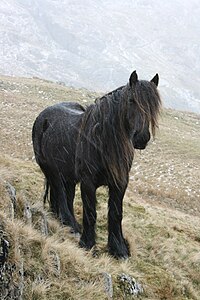
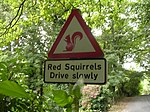
The Lake District is home to a great variety of wildlife, due to its range of varied topography, lakes and forests.
There are colonies of sundew and butterwort, two of the few carnivorous plants native to Great Britain.
It provides a home for the red squirrel (one of the few places outsde the Highlands where red squirrels have a sizeable population[5]). It is estimated there are 140,000 red squirrels in the United Kingdom, but are approximately 2.5 million grey squirrels who have displaced the indigenous red population since their introduction to the British Isles.[6]
The Lake District is home to a range of bird species, and the Royal Society for the Protection of Birds maintains a reserve in Haweswater.[7] The only nesting pair of Golden Eagles south of the Highlands can be found in the Lake District, though the hen has not been seen since 2004 while the male still remains.[8] Conservationists believe he is now the only resident golden eagle in England.[9] Following recolonisation attempts, a pair of ospreys nested in the Lake District for the time in over 150 years near Bassenthwaite Lake during 2001. Osprey's now frequently migrate north from Africa in the spring to nest in the Lake District and a total of 23 chicks have fledged in The Lakes since 2001.[10] Another bird species to have had recolonisation attempts is the Red Kite who have a population approximately 90 in the dense forest areas near Grizedale Forest|Grizedale as of 2012.[11] Conservationists hope the re-introduction will create a large Red Kite population here too.[12]
Other bird species resident to the Lake District include the buzzard, dipper, peregrine falcon and raven.[13] Seasonal birds include the ring ouzel and the redstart.[14]
The lakes of the Lake District support three rare and endangered species of fish: the vendace (Coregonus vandesius), which can be found only in Derwent Water and until 2008 in Bassenthwaite Lake.[15] Vendace have struggled in recent years with naturally-occurring algae becoming a threat and the lakes gradually getting warmer in temperature.[16] Vendace have been moved to higher lakes on a number of occasions to preserve the species, notably in 2005 and 2011.[17][18]
The Lakes are also home to two other rare species: the schelly, which lives in Brothers Water, Haweswater, Red Tarn and Ullswater, and the Arctic charr, which can be found in Buttermere, Coniston Water, Crummock Water, Ennerdale Water, Haweswater, Loweswater, Thirlmere, Wast Water, and Windermere.
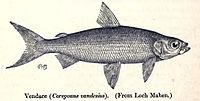
In recent years, some important changes have been made to fisheries byelaws to protect some of the rarest fish species. In 2002, the Environment Agency introduced a new fisheries byelaw, banning the use of all freshwater fish as live or dead bait in 14 of the lakes in the Lake District. Anglers not complying with the new byelaw can face fines of up to £2,500. There are 14 lakes in the Lake District which are affected. These are: Bassenthwaite Lake, Brothers Water, Buttermere, Coniston Water, Crummock Water, Derwent Water, Ennerdale Water, Haweswater, Loweswater, Red Tarn, Thirlmere, Ullswater, Wast Water and Windermere.
The lakes and waters of the Lake District do not naturally support as many species of fish as other similar habitats in the south of the country and elsewhere in Europe. Some fish that do thrive there are particularly at risk from introduction of new species.
The introduction of non-native fish can lead to the predation of the native fish fauna or competition for food. There is also the risk of disease being introduced, which can further threaten native populations. In some cases, the introduced species can disturb the environment so much that it becomes unsuitable for particular fish. For example, a major problem has been found with ruffe. This non-native fish has now been introduced into a number of lakes in recent years. It is known that ruffe eat the eggs of vendace, which are particularly vulnerable because of their long incubation period. This means that they are susceptible to predators for up to 120 days. The eggs of other fish, for example roach, are only at risk for as little as three days.
Communications
Roads
The Lake District National Park is almost contained within a box of trunk routes which cannot penetrate the mountain fastness. It is flanked to the east by the A6 road which runs from Kendal to Penrith; the A590 connects the M6 to Barrow-in-Furness and the A5092 cut across its southern fringes; the A66 runs between Penrith and Workington, cutting across its northern edge; and the A595 runs through the coastal plains of Cumberland to the west of the area linking the A66 with the A5092.
Few A roads penetrate the fells though the A591 runs northwestwards from Kendal to Windermere and then on to Keswick. It continues up the east side of Bassenthwaite Lake. "The A591, Grasmere, Lake District" has been reckoned one of the most romantic roads in the world. The A592 links Windermere with the A590 and continues northwards from Windermere to Ullswater and Penrith by way of the dramatic Kirkstone Pass.
The fells have a few passes through which roads are able to cross. The Kirkstone Pass in Westmorland climbs from Ambleside high up to descend towards Ullswater. The Wrynose and Hardknott passes run east-west and ultimately down to Cumberland's coastal towns. The Hardknott and Wrynose are known for their steep gradients and are one of the most popular if punishing climbs in the United Kingdom for cycling enthusiasts. The three shires stone marking the point where Cumberland, Lancashire and wWestmorland meet stands by the Wrybnose Pass
There are intricate networks of minor roads in the lower-lying southern part of the area connecting numerous communities between Kendal, Windermere and Coniston.
Railways and ferries
The West Coast Main Line skirts the eastern edge of the Lake District and the Cumbrian Coast Line passes through the southern and western fringes of the area. A single line, the Windermere Branch Line, penetrates from Kendal to Windermere via Staveley. Lines once served Broughton-in-Furness and Coniston and another ran from Penrith to Cockermouth via Keswick but each of these was abandoned in the 1960s. The track of the latter has been adopted in part for use by the improved A66 trunk road.
The narrow gauge Ravenglass and Eskdale Railway runs from Ravenglass on the west coast up Eskdale as far as Dalegarth Station near the hamlet of Boot, catering for tourists. Another heritage railway, the Lakeside and Haverthwaite Railway runs between the two villages encompassed within its name, tourists being able to connect with the Windermere passenger ferry at Lakeside.
A vehicle-carrying cable ferry, the Windermere Ferry runs frequent services across Windermere. There are also seasonal passenger ferries on Coniston Water, Derwent Water and Ullswater.
Economy
Agriculture and forestry
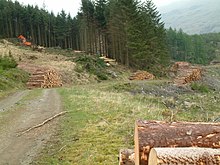
Farming, and in particular sheep farming, has been the major industry in the region since the dawn of time. The breed most closely associated with the area is the tough Herdwick, with Rough Fell and Swaledale sheep also common. Sheep farming remains important both for the economy of the region and for preserving the landscape which visitors want to see. Features such as dry stone walls, for example, are there as a result of sheep farming. Some land is also used for silage and dairy farming.
The area was badly affected by the outbreak of foot-and-mouth disease across the United Kingdom in 2001, or more particularly it was badly afffeced by the panicked reaction of the Department of Agriculture in ordering the destruction of even uninfected herds anywhere close to an outbreak. The foot and mouth outbreak was first detected in Surrey in February, but was being detected in the fells by end of March.[19] Thousands of sheep, include the native Herdwick which graze on the fellsides across the District, were destroyed. In replacing the sheep, one problem to overcome was that many of the lost sheep were heafed, that is, they knew their part of the unfenced fell and did not stray, with this knowledge being passed between generations. With all the sheep lost at once, this knowledge has to be re-learnt and some of the fells have had discreet electric fences strung across them for a period of five years, to allow the sheep to "re-heaf".[20] At the time of the outbreak, worries existed about the future of certain species of sheep such as Ryeland and Herdwick in the District,[21] however these fears have been allayed and sheep now occupy the District in abundance.[22]

Forestry has also assumed greater importance over the course of the last century with the establishment of extensive conifer plantations around Whinlatter Pass, in Ennerdale and at Grizedale Forest amongst other places. There are extensive plantations of non-native pine trees.
Industry
With its wealth of rock types and their abundance in the landscape, mining and quarrying have long been significant activities in the Lake District economy. In Neolithic times, the Lake District was a major source of stone axes, examples of which have been found all over Britain. The primary site, on the slopes of the Langdale Pikes, is sometimes described as a "stone axe factory" of the Langdale axe industry. Some of the earliest stone circles in Britain are connected with this industry.
Mining, particularly of copper, lead (often associated with quantities of silver), baryte, graphite and slate, was historically a major Lakeland industry, mainly from the 16th century to the 19th century. Coppiced woodland was used extensively to provide charcoal for smelting. Some mining still takes place today; for example, slate mining continues at the Honister Mines, at the top of Honister Pass. Abandoned mine-workings can be found on fell-sides throughout the district. The locally mined graphite led to the development of the pencil industry, especially around Keswick.
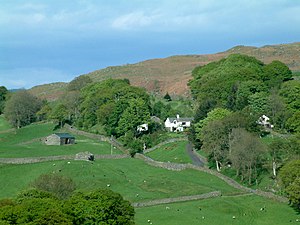
In the middle of the 19th century, half the world textile industry's bobbin supply came from the Lake District area. Over the past century, however, tourism has grown rapidly to become the area's primary source of income.
Development of tourism
Early visitors to the Lake District, who travelled for the education and pleasure of the journey, include Celia Fiennes who in 1698 undertook a journey the length of England, including riding through Kendal and over Kirkstone Pass into Patterdale. Her experiences and impressions were published in her book Great Journey to Newcastle and Cornwall:
| “ | As I walked down at this place I was walled on both sides by those inaccessible high rocky barren hills which hang over one's head in some places and appear very terrible; and from them springs many little currents of water from the sides and clefts which trickle down to some lower part where it runs swiftly over the stones and shelves in the way, which makes a pleasant rush and murmuring noise and like a snowball is increased by each spring trickling down on either side of those hills, and so descends into the bottoms which are a Moorish ground in which in many places the waters stand, and so form some of those Lakes as it did here.[23] | ” |
In 1724, Daniel Defoe published the first volume of A Tour Thro' the Whole Island of Great Britain. He commented on Westmorland that it was:
| “ | the wildest, most barren and frightful of any that I have passed over in England, or even Wales itself; the west side, which borders on Cumberland, is indeed bounded by a chain of almost unpassable mountains which, in the language of the country, are called fells.[24] | ” |
Towards the end of the 18th century, the area was becoming more popular with travellers. This was partly a result of wars in Continental Europe, restricting the possibility of travel there. In 1778 The Rev Thomas West produced A Guide to the Lakes, which began the era of modern tourism.
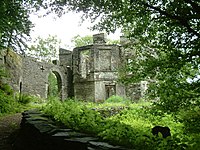
West listed "stations"—viewpoints where tourists could enjoy the best views of the landscape, being encouraged to appreciated the formal qualities of the landscape and to apply aesthetic values. At some of these stations, buildings were erected to help this process. The remains of Claife Station (on the western shore of Windermere below Claife Heights) can be visited today.
William Wordsworth published his Guide to the Lakes in 1810, and by 1835 it had reached its fifth edition, now called A Guide through the District of the Lakes in the North of England. This book was particularly influential in popularising the region. Wordsworth's favourite valley was Dunnerdale or the Duddon Valley dividing Cumberland from Lancashire in the southwest of the Lake District.
The railways led to another expansion in tourism. The Kendal and Windermere Railway was the first to penetrate the Lake District, reaching Kendal in 1846 and Windermere in 1847. The line to Coniston opened in 1848 (although until 1857 this was only linked to the national network with ferries between Fleetwood and Barrow-in-Furness); the line from Penrith through Keswick to Cockermouth in 1865; and the line to Lakeside at the foot of Windermere in 1869. The railways, built with traditional industry in mind, brought with them a huge increase in the number of visitors, thus contributing to the growth of the tourism industry. Railway services were supplemented by steamer boats on the major lakes of Ullswater, Windermere, Coniston Water, and Derwent Water.
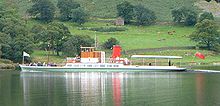
The growth in tourist numbers continued into the age of the motor car, when railways began to be closed or run down. The formation of the Lake District National Park in 1951 recognised the need to protect the Lake District environment from excessive commercial or industrial exploitation, preserving that which visitors come to see, without any restriction on the movement of people into and around the district. The M6 Motorway helped bring traffic to the Lakes, passing up its eastern flank. The narrow roads present a challenge for traffic flow and, from the 1960s, certain areas have been very congested.
Whilst the roads and railways provided easier access to the area, many people were drawn to the Lakes by the publication of the Pictorial Guide to the Lakeland Fells by Alfred Wainwright. First published between 1952 and 1965, these books provided detailed information on 214 peaks across the region, with carefully hand-drawn maps and panoramas, and also stories and asides which add to the colour of the area. They are still used by many visitors to the area as guides for walking excursions, with the ultimate goal of bagging the complete list of "Wainwrights". The famous guides are being revised by Chris Jesty to reflect changes, mainly in valley access and paths.
Since the early 1960s, the National Park Authority has employed rangers to help cope with increasing tourism and development, the first being John Wyatt, who has since written a number of guide books. He was joined two years later by a second, and since then the number of rangers has been rising.
The area has also become associated with writer Beatrix Potter. A number of tourists visit to see her family home, with particularly large numbers coming from Japan.
Tourism has now become the park's major industry, with about 12 million visitors each year, mainly from the UK's larger settlements, China, Japan, Spain, Germany and the US[25] Windermere Lake Steamers are Cumbria's most popular charging tourist attraction with about 1.35 million paying customers each year, and the local economy is dependent upon tourists. The negative impact of tourism has been seen, however. Soil erosion, caused by walking, is now a significant problem, with millions of pounds being spent to protect over-used paths.
Cultural tourism is becoming an increasingly important part of the wider tourist industry. The Lake District's links with a wealth of artists and writers and its strong history of providing summer theatre performances in the old Blue Box of Century Theatre are strong attractions for visiting tourists. The tradition of theatre is carried on by venues such as Theatre by the Lake in Keswick with its summer season of six plays in repertoire, Christmas and Easter productions, and the many literature, film, mountaineering, jazz and creative arts festivals, such as the Kendal Mountain Festival and the Keswick Mountain Festival.
Literature and art
The Lake District is intimately associated with English literature in the 18th and 19th centuries. Thomas Gray was the first to bring the region to attention, when he wrote a journal of his Grand Tour in 1769, but it was William Wordsworth whose poems were most famous and influential. Wordsworth's poem "I Wandered Lonely as a Cloud", inspired by the sight of daffodils on the shores of Ullswater, remains one of the most famous in the English language. Out of his long life of eighty years, sixty were spent amid its lakes and mountains, first as a schoolboy at Hawkshead, and afterwards living in Grasmere (1799–1813) and Rydal Mount (1813–50). Wordsworth, Coleridge and Robert Southey became known as the Lake Poets.
The poet and his wife lie buried in the churchyard of Grasmere and very near to them are the remains of Hartley Coleridge (son of the poet Samuel Taylor Coleridge), who himself lived for many years in Keswick, Ambleside and Grasmere. Robert Southey, the Poet Laureate and friend of Wordsworth (who would succeed Southey as Laureate in 1843), was a resident of Keswick for forty years (1803–43), and was buried in Crosthwaite churchyard. Samuel Taylor Coleridge lived for some time in Keswick, and also with the Wordsworths at Grasmere. From 1807 to 1815 John Wilson lived at Windermere. Thomas de Quincey spent the greater part of the years 1809 to 1828 at Grasmere, in the first cottage which Wordsworth had inhabited. Ambleside, or its environs, was also the place of residence both of Thomas Arnold, who spent there the vacations of the last ten years of his life and of Harriet Martineau, who built herself a house there in 1845. At Keswick, Mrs Lynn Linton (wife of William James Linton) was born, in 1822. Brantwood, a house beside Coniston Water, was the home of John Ruskin during the last years of his life. His assistant W. G. Collingwood the author, artist and antiquarian lived nearby, and wrote Thorstein of the Mere, set in the Norse period...
In addition to these residents or natives of the Lake District, a variety of other poets and writers made visits to the Lake District or were bound by ties of friendship with those already mentioned above. These include Percy Bysshe Shelley, Sir Walter Scott, Nathaniel Hawthorne, Arthur Hugh Clough, Henry Crabb Robinson, "Conversation" Sharp, Thomas Carlyle, John Keats, Lord Tennyson, Matthew Arnold, Felicia Hemans, and Gerald Massey.
During the early 20th century, the children's author Beatrix Potter was in residence at Hill Top Farm, setting many of her famous Peter Rabbit books in the Lake District. Arthur Ransome lived in several areas of the Lake District, and set a number of his Swallows and Amazons series of books, published between 1930 and 1947, in a fictionalised Lake District setting. So did Geoffrey Trease with his five Black Banner school stories (1949–56), starting with No Boats on Bannermere.
The novelist Sir Hugh Walpole lived at "Brackenburn" on the lower slopes of Catbells overlooking Derwent Water from 1924 until his death in 1941. Whilst living at "Brackenburn" he wrote The Herries Chronicle detailing the history of a fictional Cumbrian family over two centuries. The noted author and poet Norman Nicholson came from the south-west Lakes, living and writing about Millom in the twentieth century – he was known as the last of the Lake Poets and came close to becoming the Poet Laureate.
Writer and author Melvyn Bragg was brought up in the region and has used it as the setting for some of his work, such as his novel A Time to Dance, later turned into a television drama, though not well received.
The Lake District has been the setting for crime novels by Reginald Hill, Val McDermid and Martin Edwards. The region is also a recurring theme in Ernest Hemingway's 1926 novella The Torrents of Spring and features prominently in Ian McEwan's Amsterdam, which won the 1998 Booker Prize.
Film director Ken Russell lived in the Keswick/Borrowdale area until 2007[26] and used it in films such as Tommy and Mahler.
The Lake District is the setting for the 1977 Richard Adams novel "The Plague Dogs". Adams' knowledge of the area offers the reader a precise view of the natural beauty of the Lake District .
The former Keswick School of Industrial Art at Keswick was started by Canon Rawnsley, a friend of John Ruskin.
Names and dialect words
A number of words and phrases are local to the Lake District and are part of the Cumberland and Westmorland dialects, though many are shared by other northern dialects. These include:
- fell – from Old Norse fjallr, brought to England by Norse invaders and close to modern Norwegian fjell and Swedish fjäll meaning mountain
- howe – place name from the Old Norse haugr meaning hill, knoll, or mound
- tarn – a word that has been taken to mean a small lake situated in a corrie (the local name for which is cove), a local phrase for any small pool of water. The word is derived from the Old Norse and Norwegian word tjærn
- Yan Tan Tethera – the name for a system of sheep counting which was traditionally used in the Lake District. Though now rare, it is still used by some and taught in local schools.
- Heaf, the local word for "heft", which is to say the "home territory" of a hefted flock of sheep.
Outside links
| ("Wikimedia Commons" has material about Lake District) |
- Lake District Sports
- Cumbria Tourist Board
- Lake District Walks
- Lake District National Park Authority
- Friends of the Lake District
- Lake District at the Open Directory Project
References
- ↑ Gannon, Rock Trails Lakeland
- ↑ Gannon, Rock Trails Lakeland'
- ↑ British Geological Survey Regional memoir Northern England 5th edn 2010
- ↑ met office report
- ↑ "Red squirrels". Forestry Commission. http://www.forestry.gov.uk/forestry/INFD-5TPCW3. Retrieved 2012-08-26.
- ↑ "Prince launches innovative new drive to protect red squirrels". The Telegraph. 17 February 2011. http://www.telegraph.co.uk/earth/earthnews/8330881/Prince-launches-innovative-new-drive-to-protect-red-squirrels.html. Retrieved 2012-08-26.
- ↑ "Reserves - Haweswater". RSPB. http://www.rspb.org.uk/reserves/guide/h/haweswater/about.aspx. Retrieved 2012-09-03.
- ↑ "Golden Eagle - Population Trends". RSPB. http://www.rspb.org.uk/wildlife/birdguide/name/g/goldeneagle/population_trends.aspx. Retrieved 2012-08-26.
- ↑ Bignell, Paul (29 April 2007). "Golden Boy: England's last golden eagle". The Independent. http://www.independent.co.uk/environment/nature/golden-boy-englands-last-golden-eagle-446703.html. Retrieved 2012-08-26.
- ↑ "Osprey spotted in Cumbria at start of nesting season". BBC News. 2 April 2012. http://www.bbc.co.uk/news/uk-england-cumbria-17584430. Retrieved 2012-09-03.
- ↑ "Red kites returned to Cumbria forest after 160 years". BBC News. 3 August 2010. http://www.bbc.co.uk/news/uk-england-cumbria-10849991. Retrieved 2012-09-03.
- ↑ "Grizedale Forest sees reintroduction of red kites". BBC News. 15 May 2012. http://www.bbc.co.uk/news/uk-england-cumbria-18073449. Retrieved 2012-09-03.
- ↑ "Haweswater - Star species". RSPB. http://www.rspb.org.uk/reserves/guide/h/haweswater/star_species.aspx. Retrieved 2012-09-03.
- ↑ "Haweswater - Seasonal highlights". RSPB. http://www.rspb.org.uk/reserves/guide/h/haweswater/seasonal_highlights.aspx. Retrieved 2012-09-03.
- ↑ "Ancient vendace fish saved from edge of extinction". The Telegraph. 9 July 2009. http://www.telegraph.co.uk/earth/earthnews/3346740/Ancient-vendace-fish-saved-from-edge-of-extinction.html. Retrieved 2012-09-03.
- ↑ "Algae threatens rare fish". BBC News. 27 November 2002. http://news.bbc.co.uk/1/hi/england/2513699.stm. Retrieved 2012-09-03.
- ↑ "Endangered fish take to the air". BBC News. 30 November 2005. http://news.bbc.co.uk/1/hi/england/cumbria/4486024.stm. Retrieved 2012-09-03.
- ↑ "Llamas move fish to cooler waters in Lake District". BBC News. 12 April 2011. http://www.bbc.co.uk/news/uk-england-cumbria-13042511. Retrieved 2012-09-03.
- ↑ Cadwalladr, Carole (26 March 2001). "Lake District 'nightmare' as fell farm is infected". The Telegraph. http://www.telegraph.co.uk/news/uknews/1327961/Lake-District-nightmare-as-fell-farm-is-infected.html. Retrieved 2012-08-27.
- ↑ Griffin, Harry (11 April 2001). "'If they go, it is the end of Lakeland'". The Guardian. http://www.guardian.co.uk/uk/2001/apr/11/footandmouth.features11. Retrieved 2012-08-27.
- ↑ MacClean, Matt (21 March 2001). "Rare breeds 'could be lost'". BBC News. http://news.bbc.co.uk/1/hi/uk/1233458.stm. Retrieved 2012-08-27.
- ↑ Clarke, Tom (9 February 2011). "Sheep breed resurrected decade on from foot and mouth". Channel 4 News. http://www.channel4.com/news/sheep-breed-resurrected-decade-on-from-foot-and-mouth. Retrieved 2012-08-27.
- ↑ Celia Fiennes: Through England on a Side Saddle in the Time of William and Mary, Being the Diary of Celia Fiennes, pub. 1726
- ↑ Daniel Defoe's Tour Through the Whole Island of Great Britain, 1726 (Westmorland)
- ↑ "Desintations: Lake District". BBC\. 27 January 2005. Archived from the original on 31 January 2005. http://web.archive.org/web/20050127144348/www.bbc.co.uk/holiday/destinations/lake_district_cartmel/.
- ↑ "Coombe Cottage". Thelakedistrict.info. 11 July 2006. Archived from the original on 18 February 2009. http://web.archive.org/web/20090218052207/http://www.thelakedistrict.info/2008/11/coombe-cottage.html. Retrieved 21 April 2010.
Further reading
- Gannon, P. Rock Trails Lakeland: A Hillwalker's Guide to the Geology and Scenery, 2008, Pesda Press, ISBN 978-1-906095-15-4
- Hollingsworth, S. '"The Geology of the Lake District: a review", Proc. Geologists Assoc., 65 (Part 4) 1954
- Moseley, F. Geology of the Lake District, Yorkshire Geologic
- Lake District Tours, A Collection of Travel Writings and Guide Books in the Romantic Era in 6 vols., edited by Tomoya Oda, Eureka Press, 2008.

